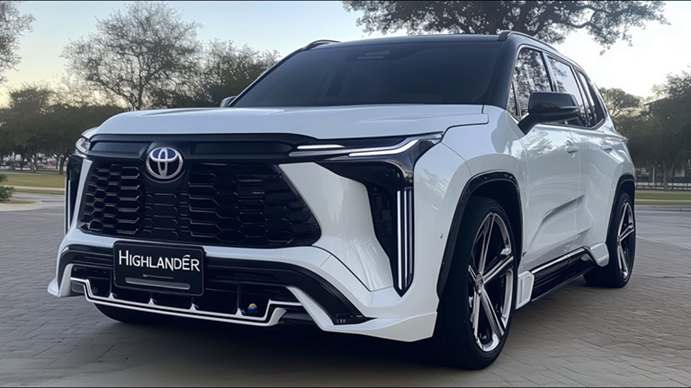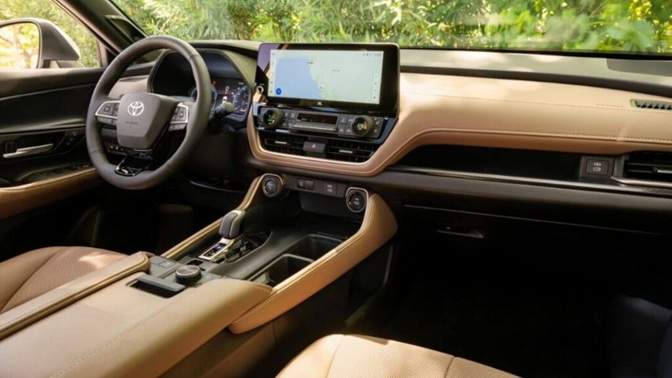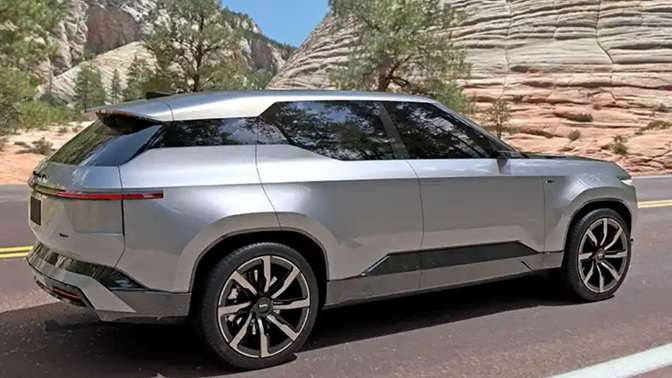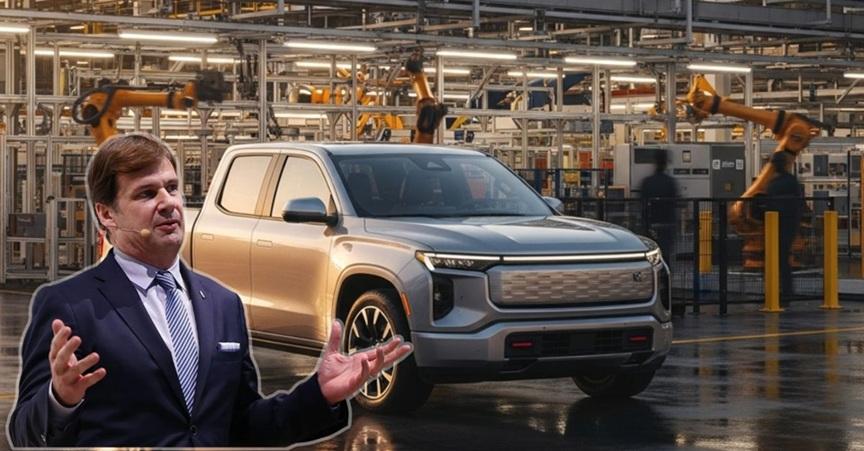If you’ve been waiting for Toyota to give its bestselling three‑row SUV a serious makeover, the 2026 Toyota Highlander Redesign is shaping up to be the model that earns your attention. The Highlander has long been a safe, sensible choice for families who need space, reliability, and decent fuel economy. But the next generation promises to be bolder — more stylish, better equipped, and more electrified — while still keeping the practical heart that made the Highlander a household name.

Below, you need to know: what Toyota is changing in the redesign, the powertrain options you’ll likely see, pricing expectations, and when you can actually get behind the wheel.
2026 Toyota Highlander Redesign: sharper, smarter
Toyota isn’t reinventing the Highlander’s wheel so much as it’s re-focusing it. Think sharper lines, a cleaner face, and a more premium interior that won’t feel out of place next to higher-priced rivals. Early preview images and design cues suggest:
- A more modern front fascia: expect a wider grille integrated with thinner LED headlights and a full-width light signature on higher trims. The look will be more sculpted and less boxy than the outgoing model.
- Cleaner side profile: a slightly lower roofline, more aggressive shoulder creases, and larger wheel options (likely 20‑ to 22‑inch on upper trims) give the Highlander a stronger stance without sacrificing practicality.
- Refined rear treatment: a continuous LED taillight bar and a tidy bumper design lend a contemporary, upscale vibe.
- A premium cabin lift: Toyota appears to have pushed the interior materials and layout up a notch — softer surfaces, more trim options (contrast stitching, wood or metallic accents), and a panoramic sunroof on higher trims.
The 2026 Toyota Highlander Redesign looks like the kind of mid‑size SUV that both parents and style-conscious buyers can live with.


Tech and comfort– Smarter Software
Toyota’s interior upgrades mean more than just prettier buttons. Expect:
- Larger central infotainment screens (12.3 inches or larger on upper trims).
- A fully digital instrument cluster on more trims, with customizable layouts and clearer graphics.
- Improved infotainment responsiveness and wireless Apple CarPlay/Android Auto as standard.
- More USB‑C ports, wireless charging, and smarter storage solutions.
- Upgraded driver assist features and an enhancement of Toyota Safety Sense, plus available hands‑free highway driving aids on higher trims.
If you spend a lot of time in the car with kids, appreciate quiet cabins on highway trips, or want reliable tech without fumbling for a manual, these updates will matter.
Powertrains Option
Toyota electrification roadmap is central to the 2026 Toyota Highlander Redesign future. For 2026, expect a lineup that balances the familiar with the forward‑looking:
- Gasoline turbocharged engine (base)
- Likely a refined 2.4‑liter turbo inline‑4 or an updated 2.5L unit.
- Estimated power: somewhere in the 270–300 hp range (dependent on final tuning).
- Paired with an 8‑ or 10‑speed automatic, with optional AWD.
- Hybrid (core offering)
- An updated hybrid system that improves both fuel economy and low‑end torque.
- Combined output likely comparable to or exceeding the current hybrid Highlander (which historically sits around the low‑ to mid‑200 hp mark), but expect better MPG and smoother electric assist.
- AWD via an electric motor on the rear axle may be standard or available.
- Plug‑in hybrid (PHEV) — rumored/possible
- Toyota has already shown success with PHEV tech on other models, and a Highlander PHEV would be a logical step for buyers wanting electric-only range for daily local driving plus combustion power for trips.
- If offered, expect an electric range in the 30–50 mile ballpark (speculation), with strong combined output and improved city efficiency.
You’ll likely be able to pick a Highlander that prioritizes fuel economy (the hybrid), outright convenience and towing (the V‑engine), or a balanced plug‑in approach if Toyota decides to offer one.

Ride, Towing, and Capability
Don’t expect the 2026 Toyota Highlander Redesign to challenge body-on-frame full-size trucks, but the refreshed chassis should feel more planted thanks to stiffer structure and improved suspension tuning. Higher trims may offer adaptive dampers for a smoother ride and better handling balance. Towing capacity will likely remain competitive for the class — expect figures that handle small trailers, boats, and weekend toys comfortably (exact numbers will come with official specs).
2026 Toyota Highlander Price Expectations
Toyota hasn’t released final pricing yet, but analysts and dealer intel give us a solid range to consider. Importantly, Toyota tends to keep base pricing reasonable while adding more options higher up the ladder.
2026 Highlander pricing (U.S., base MSRPs)
- Highlander L / Base: $37,000 – $39,000
- Highlander LE / Mid-level: $41,000 – $44,000
- Highlander XLE / Premium: $45,000 – $48,000
- Highlander Limited / Hybrid options: $49,000 – $55,000
- Highlander Platinum / Top trim (or PHEV/Capstone equivalent): $55,000 – $62,000+
2026 Toyota Highlander Estimated Price
| Trim / Variant | Typical Powertrain | Estimated Starting MSRP (USD) | Estimated Fully‑Loaded Price (USD) |
|---|---|---|---|
| L (Base) | Gas (2.4L turbo / 2.5L NA – base) | $37,000 | $40,000 |
| LE | Gas | $41,000 | $44,000 |
| XLE | Gas | $45,000 | $49,000 |
| Limited | Gas | $49,000 | $55,000 |
| Platinum (Top) | Gas | $55,000 | $62,000+ |
| Hybrid LE | Hybrid (updated 2.5L hybrid) | $44,000 | $48,000 |
| Hybrid XLE | Hybrid | $48,000 | $53,000 |
| Hybrid Limited | Hybrid | $52,000 | $58,000 |
| Hybrid Platinum | Hybrid | $58,000 | $65,000+ |
| PHEV (if offered) | Plug‑in hybrid (speculative) | $55,000 – $62,000 | $62,000 – $70,000+ |
Notes:
- Hybrid and PHEV versions will carry a price premium — possibly $2,000–$8,000 depending on battery and tech.
- Destination charges, dealer fees, and optional packages will affect final out‑the‑door pricing.
- If federal or state incentives are in place in 2026, they could materially change effective pricing for buyers.
Release Date and Availability
Toyota typically announces new model-year vehicles in the months preceding that model year. For the 2026 Toyota Highlander Redesign new model expected:
- Official reveal: likely in late 2024 or during 2025 auto shows.
- Dealer arrival / deliveries: late 2025 to early 2026.
- Initial availability: base and gas models first, with hybrid and any PHEV variants following shortly after.
If you’re considering a Highlander, plan for test drives in early 2026 and be ready to make trim choices based on actual EPA ratings and real-world reviews.
2026 Toyota Highlander Specs
| Specification | Gas (Estimated) | Hybrid (Estimated) | PHEV (Rumored / Expected) |
|---|---|---|---|
| Model / Body | 2026 Toyota Highlander — 3-row midsize SUV | Same | Same |
| Seating | 7 or 8 passengers (3-row) | 7 or 8 passengers | 7 or 8 passengers |
| Engine / Powertrain | Refined 2.4L turbo inline‑4 or updated 2.5L (NA/Turbo) | Updated 2.5L hybrid system (improved hybrid hardware) | Plug‑in hybrid variant with larger battery (if offered) |
| Estimated Combined Power | ~270–300 hp | ~240–300 hp (combined) | ~300+ hp combined (speculative) |
| Torque (est.) | TBD (likely competitive for class) | TBD (hybrid torque depends on motor tuning) | TBD |
| Transmission | 8‑ or 10‑speed automatic (est.) | eCVT / hybrid transaxle | eCVT or hybrid PHEV transmission |
| Drivetrain | FWD standard; AWD available (est.) | AWD via electric rear motor available / optional | AWD likely available (via electric motor) |
| Estimated Fuel Economy | Gas: ~20–25 mpg city / ~26–30 mpg highway (range est.) | Hybrid: ~32–36 mpg city / ~33–38 mpg highway (est.) | PHEV: Electric range ~30–50 miles (speculative); MPGe / combined TBD |
| Battery / Charging | N/A | Hybrid battery pack (size TBD) | PHEV battery capacity TBD; Level 2 AC charging (time TBD), likely 120–240V compatible |
| 0–60 mph | TBD | TBD | TBD |
| Towing Capacity (est.) | Up to ~5,000 lbs (trim & equip dependent) | Likely lower than gas V‑engine when equipped; exact TBD | Towing TBD (likely competitive with class when properly equipped) |
| Cargo Space | TBA (expected similar or slightly improved vs outgoing Highlander) | TBA | TBA |
| Instrumentation | Digital driver cluster available on more trims | Digital cluster standard or widely available | Digital cluster + PHEV energy/charge displays |
| Safety / Driver Assist | Toyota Safety Sense (upgraded suite), adaptive cruise, lane assist | Same plus enhanced hands‑free driving aids on higher trims | Same, plus PHEV charge/eco driving features |
| Estimated Price (MSRP, U.S.) | Base: ~$37,000–$39,000 (est.) | Hybrid premium: ~$45,000–$55,000 (est., depending on trim) | PHEV / top trims: ~$55,000–$62,000+ (estimate) |

How the 2026 Toyota Highlander stacks up against rivals?
The Highlander doesn’t sit alone in a crowded middle‑size SUV segment. Key competitors include the Kia Telluride, Hyundai Palisade, Honda Pilot, Subaru Ascent, and Nissan Pathfinder. Toyota’s strength has always been dependability and resale value; the 2026 redesign aims to add sharper styling and more modern tech to compete on presence and comfort.
- Telluride/Palisade: known for luxury feel and great value. Highlander will need better interior materials and tech to be in that conversation.
- Honda Pilot: practical and solid — Highlander’s hybrid advantage could be a differentiator.
- Subaru Ascent: excellent AWD and off-road cred — Highlander must match capability while offering better refinement.
2026 Toyota Highlander Competitor
| Model (2026) | Typical Powertrain | Drivetrain | Est. Starting MSRP |
|---|---|---|---|
| Toyota Highlander (2026) | Gas turbo or 2.5L hybrid; PHEV possible | FWD standard, AWD available | ~$37k–$39k (base est.) |
| Kia Telluride | 3.8L V6 | FWD/AWD | ~$36k–$39k |
| Hyundai Palisade | 3.8L V6 | FWD/AWD | ~$38k–$41k |
| Honda Pilot | Turbo 4‑cyl / Hybrid expected | FWD/AWD | ~$36k–$40k |
| Subaru Ascent | 2.4L turbo BOXER I4 | Symmetrical AWD (std) | ~$38k (est.) |
| Mazda CX‑90 | Inline‑6 turbo / PHEV options | AWD (often std) | ~$40k+ |
| Ford Explorer | 2.3L EcoBoost / hybrid options | RWD‑based / AWD available | ~$36k–$44k |
| Chevrolet Traverse | 3.6L V6 (or updated engine) | FWD/AWD | ~$35k–$38k |
| Nissan Pathfinder | 3.5L V6 / Hybrid options | FWD/AWD | ~$35k–$38k |
Who should consider the 2026 Toyota Highlander?
- Families who need a practical three‑row SUV with updated tech and improved comfort.
- Buyers who value Toyota’s reputation for long-term reliability and resale.
- Commuters wanting hybrid efficiency without jumping to full electric.
- Those who want a sensible mix of capability and modern features without paying luxury‑brand prices.
Why this 2026 Toyota Highlander redesign matters?
The Highlander has been a reliable, often invisible hero in American driveways: dependable, safe, and eminently sensible. The 2026 redesign is Toyota’s pitch to keep families in that fold while grabbing some buyers who might otherwise favor flashier rivals. If Toyota nails the balance — modern styling, better tech, solid hybrid efficiency, and a realistic price — the Highlander could return as a market leader, not just a steady seller.
Quick checklist before you buy
- Wait for EPA fuel economy and real‑world tests if you care about efficiency.
- Compare hybrid and gas prices after incentives (if any).
- If you have regular towing needs, check factory towing ratings for your chosen trim.
- Test-drive multiple trims to see which ride and feature set you prefer — the difference between an LE and a Limited can be night and day.
The 2026 Toyota Highlander looks like it will be a smart evolution: sharper styling, nicer interior, and a clearer focus on electrified powertrains. It won’t be the cheapest option on the lot, but if Toyota sticks to tried‑and‑true reliability while delivering modern tech and efficient hybrid systems, the new Highlander could be the three‑row SUV you don’t have to apologize for owning.
Want updates as Toyota releases official specs? I’ll summarize the reveal and give a trim-by-trim guide once the numbers are live — drop a comment with which highlander trim or powertrain you’re most excited about, and I’ll cover it first.
Related Post


